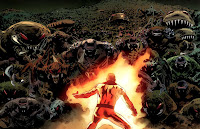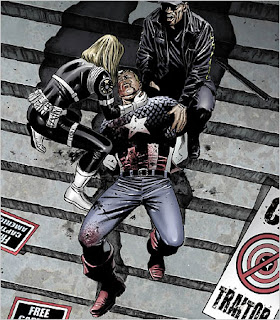This list is less about what I've read in comics, since I'm not very good at getting and reading the new stuff as it's arriving in stores and on the shelves. It's more about which events were significant enough to me throughout this year that they made it on my radar and either made me happy to be a comics geek, caused me to think about how comics were and would be affected, or made me reflect on comic books in general.
So, without further ado, here's my list:
10. Captain America: The First Avenger--I had been waiting for this movie for a long time, and was filled with adoration for it by the time the credits finished. Not only did it make a good lead-in to next year's The Avengers film, but it brought a sense of fun back into the storytelling in the Marvel Cinematic Universe, which I felt had been largely absent since we first saw it in Iron Man in 2008. We'll see if it can be replicated in The Avengers, but in the meantime this movie made for an entertaining story all on its own.
 |
| From left to right: Johnny Storm, Mary Jane Watson, Peter Parker, Gwen Stacy, May Parker. Peter's final thought to May: 'It's all been worth it, because I was able to save you.' |
9. Ultimate Spider-Man's Death--I'd been waiting for a "Death of Spider-Man" storyline for some time, not because I want to see my favorite comic book character die, but because, at some point, it happens to everybody. What makes this death noteworthy is that it's not an epic, cosmically charged saga in some grand arena. Quite the opposite: it's a neighborhood brawl, one injured, determined kid defending his family, house, and turf against six super-powered would-be murderers who all have it in for him. It makes his death all the more personal and all the more painful as a result. He's eventually succeeded by Miles Morales, a half-latino, half-black character who I haven't yet been able to follow. I should've figured they'd want to at least make it seem permanent with this character, which to me explains why they killed off the Ultimate Universe Peter Parker and not the "real," Earth-616 Spider-Man, who continues to fight crime in the pages of several publications.
8. $2.1 Million Sale of Action Comics #1--Ah, to have that kind of money. I don't know who bought it, or if it really is the copy from Nicholas Cage's collection, but I do know that the comic featuring the first appearance of Superman shattered the record for the amount paid for a comic book, set by Detective Comics #27 (Batman's first appearance) last year. Those two heroes can never stop competing with each other, it seems...
 |
| "Come on, you bastards! Let's dance!" |
7. Human Torch's Death, Replacement by Spider-Man--So, Marvel sullied this a few moths later by bringing Johnny Storm back to life for Fantastic Four #600, but at the time it was a big move, effectively leaving a large void in the roster of the legendary super-family team, the Fantastic Four. Spider-Man was tapped to replace him, which he did for a while, bonding with Johnny's nephew Franklin and doing what he could to bring levity and an edge to the team. Now things are more or less back to normal--as normal as they get in the Marvel Universe, anyway--but there's no denying the impact felt all around during this time.
 6. DC's Mega-Reboot--I've never been a huge DC Comics fan, but I do like the Batman titles and the occasional Superman story. That said, when I heard about the impending reboot of the entire DC Universe and the re-launching of 52 of their titles at issue #1, I couldn't help but think that this was a horrible idea. Knowing as you might how I feel about the use of the reset button on comics continuity (in short: if you do it, it better be damn good), I was pretty sure this would end disastrously for DC. I haven't seen any of the new titles yet, but the initial reviews seem to be, for the most part, very positive. Hopefully DC will pull this off, and I'll have a convenient jumping-in point for more aspects of their mythology. At this point, only time will tell.
6. DC's Mega-Reboot--I've never been a huge DC Comics fan, but I do like the Batman titles and the occasional Superman story. That said, when I heard about the impending reboot of the entire DC Universe and the re-launching of 52 of their titles at issue #1, I couldn't help but think that this was a horrible idea. Knowing as you might how I feel about the use of the reset button on comics continuity (in short: if you do it, it better be damn good), I was pretty sure this would end disastrously for DC. I haven't seen any of the new titles yet, but the initial reviews seem to be, for the most part, very positive. Hopefully DC will pull this off, and I'll have a convenient jumping-in point for more aspects of their mythology. At this point, only time will tell.
5. Wizard Magazine Fades to Nothing--Wizard Magazine first started just a couple of years after I first started reading and collecting comics, so when it was announced that it would cease print publication this year and go digital as Wizard World Magazine, I was more than a little upset. As for the existence of the digital magazine... it does exist, but it's not easy to find without a link. In any case, it seems now it covers pop culture and film in addition to comics. I might check them out occasionally for information gathering purposes, but I don't see them making my feed reader. It's nothing like the Wizard Magazine I remember.
4. Digital Comics Same-Day Delivery Becomes the Norm--I don't yet really read comics digitally--my main method is to check the collected paperbacks out from the library--but it's not hard to imagine the impact this will have on the industry. Until recently, you basically had to wait a little longer for the digital version of a comic to come out than the print. The argument was that if you could access the digital version at the same time as the print version, sales of the print comic would be hurt. DC in particular seems to have decided to see if this is actually true, and it looks like others will be following suit as well. Movie industry, you might consider taking a page from the comics in this arena...
3. Batman: Arkham City--Oh. Wow. What a game! I'd actually just played its predecessor, Batman: Arkham Asylum, earlier this year, so by the time October came around, I was primed and eager to continue the saga told in these amazing games. If you want a video gaming experience that will come as close as possible to letting you actually be Batman, then look no further. Arkham City expands the playing area and continues much of the story began in Arkham Asylum, featuring plenty of action, fighting, puzzles to solve, and a healthy dose of villains from Batman's infamous rogues gallery. Add to that a number of developments and Easter Eggs, including a plot twist that you would never expect to see coming, and you'll virtually be screaming for another sequel.
 |
| Mike Meyer, St. Louis resident. Superman fan. Robbery victim. |
2. Superman Fan Robbed--One of the more memorable events of 2011 was unfortunately one of the most appalling, in which Mike Meyer, a St. Louis resident who is a big fan of Superman, was robbed by a former co-worker of a significant bulk of his collection of Superman memorabilia. The robber, professional jerk Gerry Armbruster, quietly removed the items in question from Meyer's house while an accomplice distracted him by watching Superman films. It's a story that fills you with disgust at just how despicable some people can be. Of course, without events like this we wouldn't get reactions like the next one...
1. Superman Fans Respond to Robbing With Generosity--This was far and away my favorite moment in comics this year, and made me proud of just how generous people can be. Fans from across the country and across the world sent Meyer replacement gifts for his stolen Superman collection, and did so in droves. And though the jerk who robbed him in the first place was soon caught, it was uplifting and reassuring in the meantime to see so many comics enthusiasts come to the aid of this one Superman fan who really needed it.
And there you have it. I felt that 2011 was a good year for comics, and look to 2012 with a cautious hope that things will be even bigger and better. As technology and economics influence our reading habits and the way comics are created, and the companies that make them respond, there's no doubt that many interesting changes are in store for the industry in the near future. In the meantime, I'll continue reviewing, commenting, and musing on comics.
There will doubtless be much to talk about!
There will doubtless be much to talk about!






















